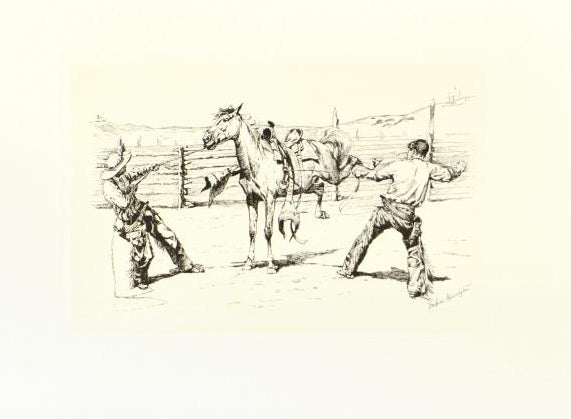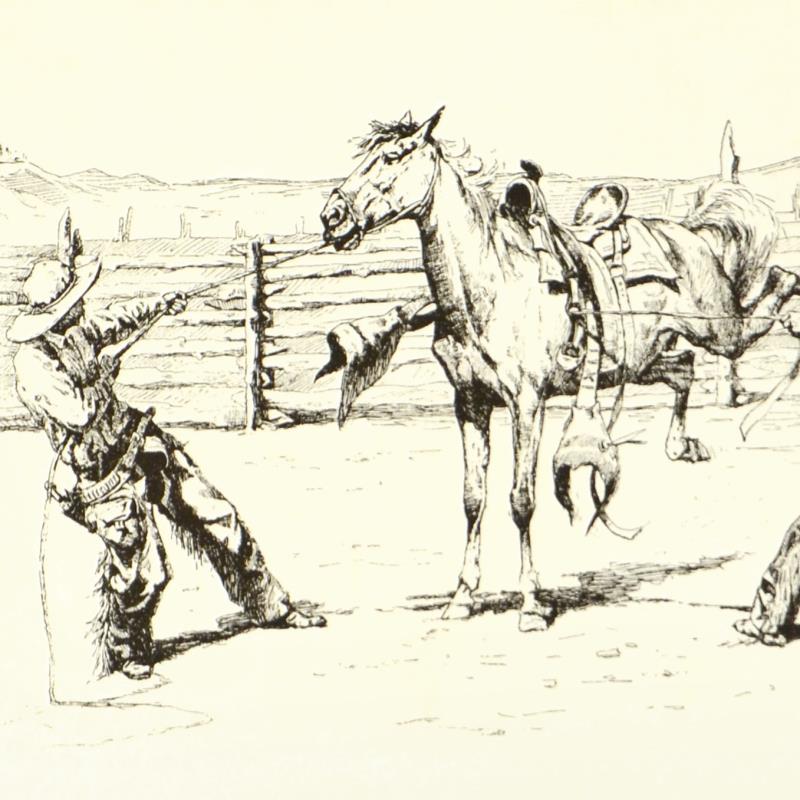Frederic Remington (October 4, 1861 – December 26, 1909) was an American painter, illustrator, sculptor, and writer who specialized in depictions of the American Old West, specifically concentrating on scenes from the last quarter of the 19th century in the Western United States and featuring images of cowboys, the U.S. Cavalry, Native Americans, cowboys, horses, and other aspects of life on the plains. Frederic Remington studied art at Yale University (1878–80) and briefly (1886) at the Art Students League of New York. Thereafter he devoted himself primarily to illustrative work. On those trips Frederic Remington sketched and photographed continuously, amassing material to take back to and work from in his studio in New York City.
In 1886, Frederic Remington was sent to Arizona by Harper's Weekly on a commission as an artist-correspondent to cover the government's war against Geronimo. Although he never caught up with Geronimo, Remington did acquire many authentic artifacts to be used later as props, and made many photos and sketches valuable for later paintings. He also made notes on the true colors of the West, such as "shadows of horses should be a cool carmine & Blue", to supplement the black-and-white photos. Ironically, art critics later criticized his palette as "primitive and unnatural" even though it was based on actual observation. Later that year, Remington received a commission to do eighty-three illustrations for a book by Theodore Roosevelt, Ranch Life and the Hunting Trail, to be serialized in The Century Magazine before publication. The 29-year-old Roosevelt had a similar Western adventure to Remington, losing money on a ranch in North Dakota the previous year but gaining experience which made him an "expert" on the West. The assignment gave Remington's career a big boost and forged a lifelong connection with Roosevelt.
Frederic Remington kept up his contact with celebrities and politicos, and continued to woo Theodore Roosevelt, now the New York City Police Commissioner, by sending him complimentary editions of new works. Despite Roosevelt's great admiration for Remington, he never purchased one of his paintings or drawings. Remington's association with Roosevelt paid off, however, when the artist became a war correspondent and illustrator during the Spanish American War in 1898, sent to provide illustrations for William Randolph Hearst's New York Journal. He witnessed the assault on San Juan Hill by American forces, including those led by Roosevelt. His heroic conception of war, based in part on his father's Civil War experiences, were shattered by the actual horror of jungle fighting and the deprivations he faced in camp. His reports and illustrations upon his return focused not on heroic generals but on the troops, as in his Scream of the Shrapnel (1899), which depicts a deadly ambush on American troops by an unseen enemy. When the Rough Riders returned to the U.S., they presented their courageous leader Roosevelt with Remington's bronze statuette, The Broncho Buster, which the artist proclaimed, "the greatest compliment I ever had…After this everything will be mere fuss." Roosevelt responded, "There could have been no more appropriate gift from such a regiment".
Frederic Remington was one of the first American artists to illustrate the true gait of the horse in motion (along with Thomas Eakins), as validated by the famous sequential photographs of Eadweard Muybridge. Previously, horses in full gallop were usually depicted with all four legs pointing out, like "hobby horses". The galloping horse became Remington's signature subject, copied and interpreted by many Western artists who followed him, adopting the correct anatomical motion. Though criticized by some for his use of photography, Remington often created depictions that slightly exaggerated natural motion to satisfy the eye. He wrote, "the artist must know more than the camera ... (the horse must be) incorrectly drawn from the photographic standpoint (to achieve the desired effect)." Also, noteworthy was Remington's invention of "cowboy" sculpture. From his inaugural piece, The Broncho Buster (1895), he created an art form which is still very popular among collectors of Western art. An early advocate of the photoengraving process over wood engraving for magazine reproduction of illustrative art, Remington became an accepted expert in reproduction methods, which helped gain him strong working relationships with editors and printers.
Frederic Remington, in addition to numerous trips into the American West, also visited Canada and Mexico in pursuit of the subjects of his art. He produced nearly 3,000 drawings and paintings, 25 sculptures, and eight volumes of writings throughout his career. He died December 26, 1909 following an emergency appendectomy that was performed at his home in Ridgefield, Connecticut.

 Vendor:A Pull at the Canteen - Etching by Frederic Remington (1861-1909)Art Deals
Vendor:A Pull at the Canteen - Etching by Frederic Remington (1861-1909)Art Deals
 Vendor:Bronco Busters Saddling Etching by Frederic Remington (1861-1909)Art Deals
Vendor:Bronco Busters Saddling Etching by Frederic Remington (1861-1909)Art Deals





